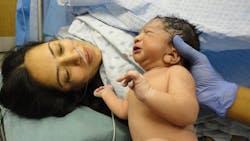Pregnant women exposed to too much nitrate in their drinking water are at greater risk of giving birth prematurely, according to a Stanford University study of more than 1.4 million California births.
Agricultural runoff containing fertilizer and animal waste can greatly increase the nitrate level in groundwater, which naturally contains a low level of the chemical.
“We found that higher concentrations of nitrate in drinking water during pregnancy were associated with an increased risk of spontaneous preterm birth, even at nitrate concentrations below the federal regulatory limit,” said Allison Sherris, a graduate student in the Emmett Interdisciplinary Program in Environment and Resources at Stanford. “That was surprising.”
The study, which published online May 5 in Environmental Health Perspectives, is the largest ever to connect nitrate exposure and premature birth. Sherris is the lead author. The senior author is Gary Shaw, DrPH, professor of pediatrics.
The research found that the risk of early preterm birth, in which an infant is born at least nine weeks early, more than doubled among women whose tap water had nitrate levels that exceeded the federal limit of 10 milligrams per liter compared with those whose tap water nitrate levels were less than 5 milligrams per liter. The risk was elevated by about half among women exposed to a moderate level of 5-10 milligrams per liter of nitrate in their water. Later preterm births, in which an infant arrives three to eight weeks early, were also associated with elevated nitrate, but the connection was less pronounced.
The federal safety limit of nitrate in drinking water was set after it was discovered that newborns drinking formula mixed with high-nitrate water can develop “blue baby” syndrome, in which infants’ blood carries too little oxygen. Both fetuses and young infants have a special oxygen-carrying protein in their blood called fetal hemoglobin, which is especially susceptible to damage by nitrate.
The study drew on records of more than 1.4 million births of sibling pairs who were born to about 650,000 women in California between 2000 and 2011. The siblings in the study were not twins or other multiples but had the same mother. Comparing siblings helped the researchers control for factors that might influence preterm birth independently of nitrate exposure, such as the mothers’ genetics, socioeconomic status and dietary habits.
“The within-mother approach gives us confidence in our findings,” Sherris said.
The researchers used public data on nitrate levels in local drinking water systems at the mothers’ homes to estimate their nitrate exposures during each pregnancy. Some women in the study had the same exposures for multiple pregnancies; whereas, other women were exposed to different nitrate levels, either because the amount in their local drinking water changed, or because they moved between pregnancies.
Compared with women exposed to the lowest nitrate level of less than 5 milligrams per liter, the odds of spontaneous preterm birth occurring nine or more weeks early was 47% higher in women exposed to 5-10 milligrams per liter, and 252% higher in women exposed to more than 10 milligrams per liter in drinking water.
The strongest effects of nitrate on prematurity risk were seen in California’s agricultural regions, including the San Joaquin Valley and the Inland Empire, the study noted.

